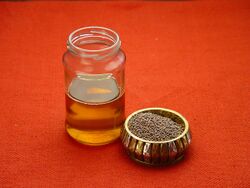Chemistry:Mustard oil
Mustard oil can mean either the pressed oil used for cooking, or a pungent essential oil also known as volatile oil of mustard. The essential oil results from grinding mustard seed, mixing the grounds with water, and isolating the resulting volatile oil by distillation. It can also be produced by dry distillation of the seed. Pressed mustard oil is used as cooking oil in some cultures, but sale is restricted in some countries due to high levels of erucic acid. Varieties of mustard seed also exist that are low in erucic acid.
Pressed oil
Oil makes up about 30% of mustard seeds. It can be produced from black mustard (Brassica nigra), brown mustard (B. juncea), and white mustard (B. alba).
Culinary use
Having a distinctive pungent taste, the use of the oil is a feature of predominantly Punjabi Assamese, Bengali and North Indian cooking,[1][2] as well as Bangladeshi cuisine.[3] It is sometimes used as a substitute for ghee.[4]
Chemical composition
Its pungent flavor is due to allyl isothiocyanate, a phytochemical of plants in the mustard family, Brassicaceae (for example, cabbage, horseradish or wasabi).
Mustard oil has about 60% monounsaturated fatty acids (42% erucic acid and 12% oleic acid); it has about 21% polyunsaturated fats (6% the omega-3 alpha-linolenic acid and 15% the omega-6 linoleic acid), and it has about 12% saturated fats.[5]
Potential toxicity
Mustard oil has high levels of erucic acid. Erucic acid may have toxic effects on the heart at high doses.[6] An association between the consumption of dietary erucic acid and increased myocardial lipidosis, or heart disease, has not been established.[7]
The U.S. Food and Drug Administration prohibits the import or sale of expressed mustard oil in the U.S. for use in cooking due to its high erucic acid content. By contrast, the FDA has classified essential mustard oil, which has a much lower erucic acid content, as generally recognized as safe, and allows its use in food.[8][9] Expressed mustard oil is permitted in the U.S. as a massage oil, with a required "for external use only" label.[3]
Nutritional information
According to the USDA,[10] 100 grams of mustard oil contains 884 calories of food energy, and is 100% fat. The fat composition is 11% saturated fat, 59% monounsaturated fat, and 21% polyunsaturated fat.[11]
Essential oil
This section needs additional citations for verification. (August 2020) (Learn how and when to remove this template message) |
The pungency of the condiment mustard results when ground mustard seeds are mixed with water, vinegar, or other liquid (or even when chewed). Under these conditions, a chemical reaction between the enzyme myrosinase and a glucosinolate known as sinigrin from the seeds of black mustard (Brassica nigra) or brown Indian mustard (Brassica juncea) produces allyl isothiocyanate. By distillation one can produce a very sharp-tasting essential oil, sometimes called volatile oil of mustard, containing more than 92% allyl isothiocyanate. The pungency of allyl isothiocyanate is due to the activation of the TRPA1 ion channel in sensory neurons. White mustard (Brassica hirta) does not yield allyl isothiocyanate, but the milder 4-Hydroxybenzyl isothiocyanate degraded from sinalbin rather than sinigrin.[12]
Allyl isothiocyanate serves the plant as a defense against herbivores. Since it is harmful to the plant itself, it is stored in the harmless form of a glucosinolate, separate from the enzyme myrosinase. Once the herbivore chews the plant, the noxious allyl isothiocyanate is produced. Allyl isothiocyanate is also responsible for the pungent taste of horseradish and wasabi. It can be produced synthetically, sometimes known as synthetic mustard oil.[13]
See also
- List of mustard brands
- Mustard plant
- Mustard seed
- Mustard (condiment)
- Mustard cake
References
- ↑ Krishnendu Ray, The Migrant's Table: Meals and Memories in Bengali-American Households (Temple University Press, 2004), p. 27: "Wide use of mustard brings Bengali food close to the North Indian paradigm"
- ↑ Pete Wells, Masalawala & Sons, Where the Food Is Bengali and the Mustard Oil Flow , New York Times (January 24, 2023): "The volatile, sinus-awakening aroma of mustard oil is one of the signatures of Bengali cooking. ... Many Bengali dishes are unthinkable without it."
- ↑ 3.0 3.1 Indrani Sen, American Chefs Discover Mustard Oil , New York Times (November 2, 2011): "It is also used as a massage oil, the only use for which it is legally approved in the United States."
- ↑ The Cook's Book of Ingredients (DK Publishing: 1st American ed., 2010), p. 513.
- ↑ "FDA FoodDataCentral Oil, mustard". https://fdc.nal.usda.gov/fdc-app.html#/food-details/172337/nutrients.
- ↑ Food Standards Australia New Zealand (June 2003) Erucic acid in food : A Toxicological Review and Risk Assessment . Technical report series No. 21; Page 4 paragraph 1; ISBN:0-642-34526-0, ISSN 1448-3017
- ↑ Food Standards Australia New Zealand (June 2003) Erucic acid in food: A Toxicological Review and Risk Assessment Technical report series No. 21; Page 4 paragraph 1; ISBN:0-642-34526-0, ISSN 1448-3017
- ↑ FDA Import Alert 26-04: Detention Without Physical Examination of Expressed Mustard Oil , FDA (November 18, 2016).
- ↑ Mustard and Mustard Oil Safety , National Capital Poison Center] (last accessed January 26, 2023).
- ↑ "Welcome to the USDA Food Composition Database" (in en). https://fdc.nal.usda.gov/.
- ↑ "(Retrieved 2017-12-11)". https://fdc.nal.usda.gov/fdc-app.html#/food-details/172337/nutrients.
- ↑ "Mustard". A Guide to Medicinal and Aromatic Plants. Center for New Crops and Plant Products, Purdue University. http://www.hort.purdue.edu/newcrop/med-aro/factsheets/MUSTARD.html.
- ↑ "Mustard Oil, Synthetic". JT Baker. http://hazard.com/msds/mf/baker/baker/files/p3225.htm.
 |



